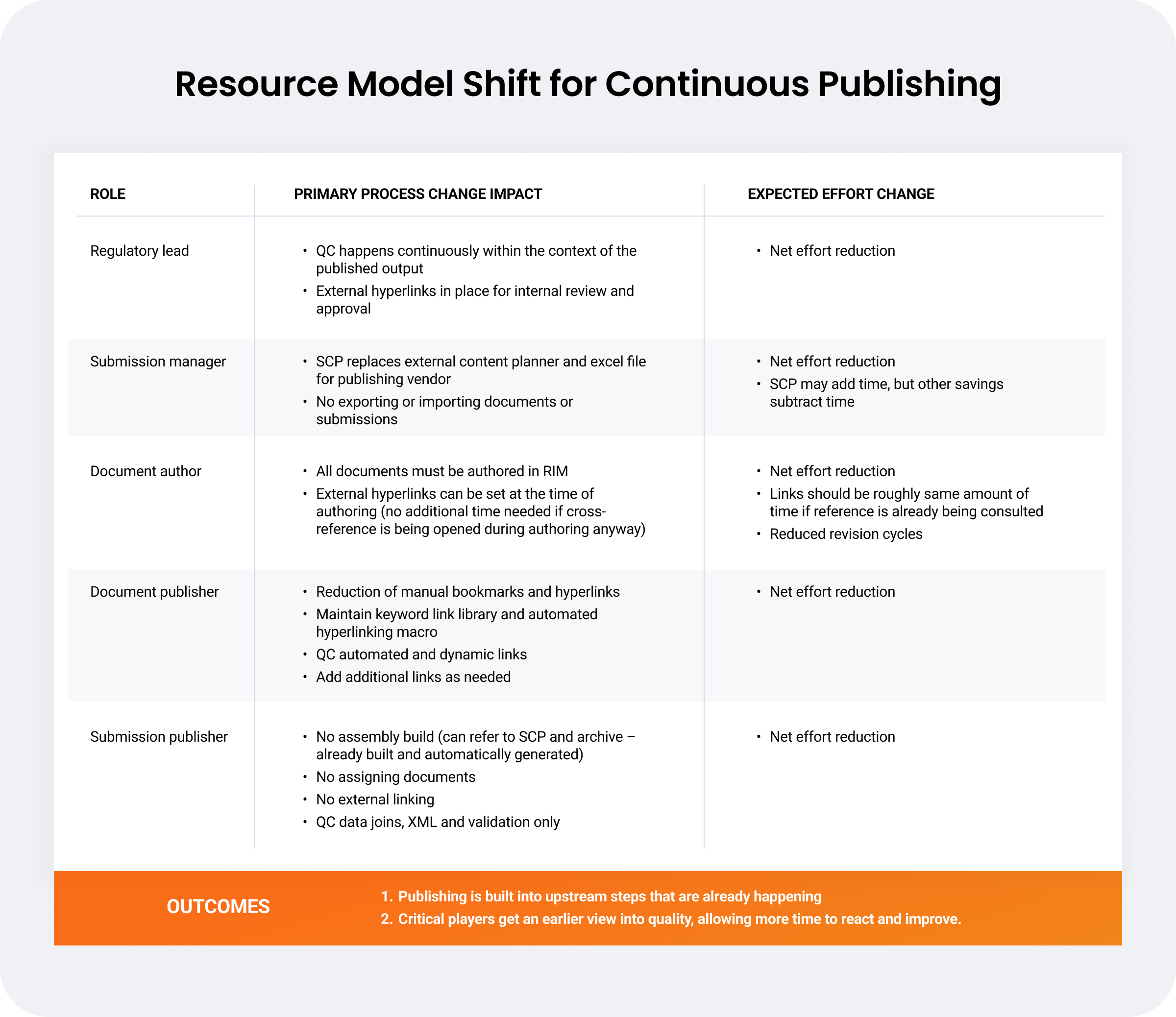Blog
3 Keys to Successfully Accelerate Submissions Timelines
Nov 08, 2024 | Alison Marjanowski
Nov 08, 2024 | Alison Marjanowski
Speed, innovation, and increased competition in the R&D pipeline put increased pressure on biopharmas, large and small, to improve efficiency and work faster across the organization. Regulatory teams are automating historically intensive, manual steps and unifying process silos to accelerate regulatory submissions. To improve submission preparation efficiency, many biopharmas are bringing submissions publishing in-house as part of their unified RIM platform.
Moving to an in-house, continuous publishing model has clear advantages:
- Increased efficiency: While initial set-up for in-house publishing can require investment in tech and implementation teams, over time, it reduces long-term reliance on third-party vendors, reduces expenses, and builds internal expertise. System consolidation coupled with process automation increases the team’s productivity, saving significant resources over time. For companies planning a new market launch, a time savings of just a few days can significantly increase top-line revenue.
- Better control and flexibility: Continuous publishing gives direct control over timelines, changes, and updates. Flexibility is critical in fast-moving and frequently changing regulatory environments, where the traditional linear process increases the risk of delays in submissions and responses to health authorities (HAs). More control over the process lets teams collaborate and communicate closely, react sooner to changes with fewer re-work steps, and execute parallel authoring and publishing workflows that optimize time to submission.
- Improved quality and compliance: Bringing publishing in-house lets teams closely monitor and enforce regulatory standards and data quality. This ownership ensures consistency and accuracy, reducing errors that can lead to delays. It also allows for increased alignment with internal processes and systems.
Moving to a continuous publishing model can reduce submission preparation timelines by as much as 50%, shaving days to weeks off of the time to submission. Successfully shifting to this model requires a well-planned and structured approach. Read on to learn what training and resources you can use to manage this change and reap the benefits of bringing publishing in-house.
1. Understand how your resource model shifts
Continuous publishing automates much of the publishing (downstream) process based on work completed during planning and authoring (upstream). The remaining work can be done in parallel, rather than sequentially. See here for a more detailed process flow diagram. This automation frees up bandwidth to focus more on quality and process improvement.
Consider addressing knowledge gaps as you bring the process in-house. You will need someone who understands the basic concepts of eCTD publishing and validation. Some companies continue to leverage third-party publishers to work within their in-house systems, some hire publishers, and others simply train existing resources on the basics of publishing. All three approaches can work well.
Below is a resource change analysis for a customer based on their specific operating model and current baseline process:

2. Identify and recruit your champions
Regulatory teams usually have deep knowledge of regulatory requirements and complex processes that make up the submission preparation process. While moving to continuous publishing increases efficiency and eliminates rework, it does require a change to long-standing processes and mindsets.
There are a few types of champions who can help you on this journey.
A senior leader who understands the benefits and is willing to push teams to implement the new process can empower teams across the organization to drive this change. Communicating benefits and setting clear expectations across the business will ease the burden on regulatory teams and make the organization more successful.
Identifying at least one other forward-thinking individual in your organization is helpful. The following are examples of additional champions that can help your cause:
- Regulatory strategist or submission manager who is open-minded to working on content planning in a collaborative platform instead of Excel and Word
- Publisher who is open to working more frequently in Word versus Adobe and is open-minded to an interface and process that looks very different than the traditional approach
- Regulatory writer who is open to adding external links as they author
- Any regulatory team member who is a systems thinker and genuinely interested in process improvement
3. Build a plan for end-user support, which includes robust training
Continuous publishing requires a shift in the way teams work in a couple of key ways: 1) moving them from static, local documents to working in a RIM platform and 2) executing parallel submission preparation workflows instead of sequentially. Teams will feel more secure in this change if they also have access to the advanced training they need.
But you don’t need to start from scratch. Understand the training your technology partner offers and tailor it to fit your organization. Vault Submissions Publishing eLearning provides training and education on creating compliant publishing content from the initial planning stages to final submission. This type of self-service training aids transition and can help users:
- Onboard team members quickly by learning key processes and best practices
- Stay up-to-date on new releases
- Get on-the-job training for critical use cases, like region-specific publishing
Leaders should focus on the relevance and effectiveness of training materials, tailoring them closely to each user’s role, skill gaps, and objectives, as well as making training documentation easy to update. Evaluating participation and the effectiveness of your training program is also essential.
In addition to training, your champions can lead internal training, showcase the new process’s success, answer questions, and communicate broadly across the organization. This strengthens your training program and can be a rewarding way for team members to take initiative, share regulatory knowledge, and drive change across the regulatory organization.
Leverage frequent updates to drive continuous improvement
Once you have successfully launched your new process, it’s important to adopt a continuous improvement approach post-implementation. Cloud-based solutions like Veeva Vault RIM help companies respond with agility to industry changes with three automated releases per year. Delivering fast and easy updates completed in minutes to hours by a few dedicated systems and business administrators allows biopharmas to keep up with new capabilities and regulations.